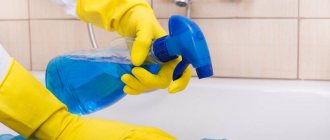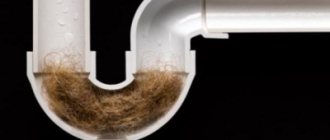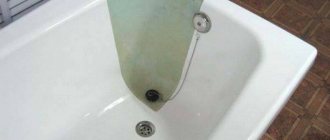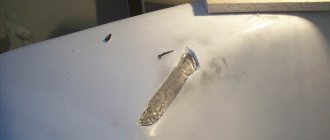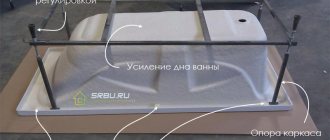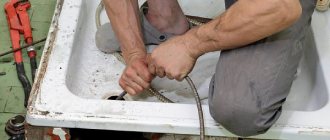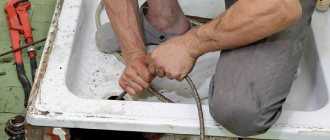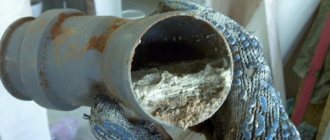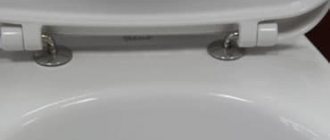When I was renovating my bathroom, I insisted on having an acrylic bathtub installed. It is so pleasant, it immediately reminds me of spa and relaxation, modern, warm and light. In general, my favorite. And then, of course, the question arose of how to clean an acrylic bathtub at home, since I wanted it to always be perfectly white and serve our family for a long time. After all, no matter what cleaning agent is suitable, it can scratch and ruin the surface. Here are my observations and tips for caring for an acrylic bathtub at home.
Everything from A to Z about the properties of an acrylic bathtub surface
Acrylic is a multicomponent polymer material obtained as a result of the synthesis of acrylic, methacrylic acids and fillers, soluble in water. To harden the acrylic, a hardener is added. After drying, acrylic is guaranteed to acquire a stable color and a reliable, durable coating for many years, which requires systematic and proper care. An acrylic bathtub is a plastic bathtub with a layer of acrylic applied to the inner surface. There are acrylic bathtubs with and without a reinforced layer, but the care for all types of acrylic bathtubs is the same.
How to care for an acrylic bathtub at home and what to clean it with? To answer this question, let's first get acquainted with the properties of acrylic bathtub coating, since these pros and cons directly affect recommendations for the proper use and care of such bathtubs.
Properties of acrylic bathtub surface
First, let's consider all the advantages and advantages of acrylic bathtubs: • a snow-white glossy acrylic surface, which has a very neat, aesthetic and attractive appearance, leaves no one indifferent, as they say - pleasing to the eye; • low thermal conductivity coefficient allows you to maintain the temperature of the collected hot water for a long time. In such bathtubs, the water remains warm much longer than in cast iron and steel bathtubs; • increased antibacterial properties of the acrylic coating due to the absence of micropores in the surface, which prevents various bacteria and microorganisms from collecting on the surface of the bathtub. Moreover, this is important at constant high humidity and temperature in bathrooms, where the most favorable conditions usually exist for the emergence and spread of various kinds of bacteria and microorganisms; • during the operation of the bathtub, chips often appear on its surface from impacts of various heavy objects. If the impact damages the enamel that covers steel and cast iron bathtubs, then a source of corrosion will inevitably subsequently arise in this place. This does not affect the surface of acrylic bathtubs, which is also one of the advantages of acrylic bathtubs. Plastic baths never corrode; • plastic bathtubs, on which a layer of acrylic is applied, are lightweight. This is a big advantage during transportation, lifting and installation compared to cast iron bathtubs; • acrylic bathtubs come in a variety of shapes, designs and sizes. A large selection of models of such plumbing products is also one of the advantages when a buyer chooses between an acrylic and a cast iron or steel bathtub; • the acrylic surface of the bathtub is very easy to clean from dirt at home. Cleaning products are produced by many manufacturers and are very affordable for almost any consumer. Along with so many advantages of acrylic bathtubs, there are also disadvantages of acrylic surfaces. All the disadvantages and disadvantages of acrylic bathtubs: • low resistance to high temperatures. Acrylic cannot withstand and begins to melt at temperatures of 100 degrees Celsius and above. Naturally, almost no one allows water with a temperature close to 100 degrees Celsius to enter the bathtub, but very hot water, combined with great mechanical stress from the large weight of the collected water, sometimes leads to deformation of the surface. This primarily applies to inexpensive bathtub models that are made from cheap and thin plastic; • although acrylic bathtubs have a certain hardness and strength, do not forget that they are still plastic. The highest quality and most expensive plastic will serve you for a maximum of 10 years, after which it begins to lose its properties. In addition, it should be noted that cheap samples of acrylic bathtubs are made of thin plastic, the strength of which is far from that of their expensive counterparts. Sometimes this leads to the fact that the weak plastic bottom simply cannot withstand the loads of the accumulated water and the weight of the human body. As a result, the acrylic bathtub cracks, and in most cases cracks through, which can lead to flooding of the neighbors on the floor below; • at the same time, the surface of an acrylic bathtub is easy to scratch, and with a strong impact, it can be pierced through; • possible yellowing of the acrylic surface of the bathtub after a certain period of time. Yellowness does not always occur. If low-quality materials were used in the production of an acrylic bathtub, in particular a hardener, then the appearance of yellowness after a certain period of time is inevitable. Yellowness also appears due to exposure to chlorine, which is present in certain quantities in tap water; • low resistance of acrylic coating to household chemicals. When caring for an acrylic bathtub at home, you should not use any detergents or cleaning products. In simple words, acrylic bathtubs cannot be washed with anything. Acrylic is afraid of household chemicals containing: • chlorine and all its varieties - the surface under the influence of chlorine loses its shine, turns yellow and slowly deteriorates due to the formation of pores, which reduce the life of the product; • acetone and other solvents corrode plastic, resulting in cloudiness and dents; • ammonia, as well as most bleaches that contain it, destroys the molecular structure of acrylic; • all formaldehydes are incompatible with all types of acrylates in their composition; • under the influence of alcohols, alkalis and acids, acrylic melts. In order for your new shiny acrylic bathtub to serve for a long time and delight the eye with its radiant appearance, it is necessary to take into account all the above features of the properties of acrylic bathtub surfaces.
Summarizing
Acrylic bathtubs have been firmly established for quite some time in the everyday life of modern people. These are lightweight, durable and easy-to-care accessories that are available in both price ranges and are ideal in the choice of shapes and color variety. In addition, acrylic has lower thermal conductivity, unlike metal, and this is a significant saving of money. Therefore, it is quite important to know how to clean or wash an acrylic bathtub, otherwise you can cause irreparable damage to the coating and it will need to be restored, and this is quite expensive.
Proven equipment for caring for an acrylic bathtub
To clean the surface of the bathtub, use soft ordinary sponges, soft rags with lint, such as flannel and microfiber, and fabric napkins. It is strictly forbidden to use any sponges that have an abrasive coating, which can scratch the acrylic coating. Do not use hard brushes, scrapers, sponges or scourers.
The acrylic coating scratches easily. We do not recommend storing metal or sharp objects on the shelves above the bathtub. If such objects are accidentally dropped, chips and scratches may occur.
Some tips for using cleaning products
Before cleaning contaminants, they learn how to work with certain types of products.
- Liquids are distributed over the internal surfaces of the bath with a soft sponge. Let it stand for up to 20 minutes, taking into account the degree of contamination. Then the residues must be thoroughly washed off with a stream of water.
- Apply the gel carefully in an even layer using a soft sponge.
- The spray is sprayed for several minutes, trying to cover the entire inner surface of the bath.
- On minor stains, leave the cleaning composition on for five minutes until rinsed off. If deposits of soap and salts have become ingrained, then it is better to extend the time to 20 minutes.
After washing off the residue, wipe the bath with a dry soft cloth.
Secrets of experiments: folk remedies - benefit or harm?
Here we provide a list of folk remedies that can be used correctly to wash away certain types of stains. However, we do not recommend their constant use for cleaning acrylic bathtubs at home, if only because none of them restores the acrylic shine of the bathtub coating.
Baby soap
We do not recommend constantly using baby soap, although it is made from ingredients that are safe for the health of the child.
Using baby soap, you can wash fresh, small stains just once, but not all of them. Therefore, baby soap is unsuitable for the permanent care of acrylic bathtubs.
Laundry soap
During the collapse of the former USSR at the end of the last century and the total shortage, laundry soap as a means for cleaning bathtubs became very widespread.
Firstly, laundry soap, due to its low cost, was widely available. Secondly, laundry soap was always produced in sufficient quantities and was never a scarce product. Thirdly, laundry soap was absolutely safe in its chemical composition.
If anyone remembers, in those days infants were bathed with laundry soap. In those days, the use of laundry soap was entirely justified. But times change, and laundry soap is no exception. GOST standards have been changed several times over the course of several decades. Accordingly, the chemical composition of laundry soap has changed a lot, and not for the better.
As they say, now “the entire periodic table” is in laundry soap. Therefore, now it should not be used as a detergent for cleaning acrylic bathtubs, and at maximum, you can simply damage the acrylic coating with the aggressive components included in its composition.
This is not only a theory, there are also not isolated cases in practice when a new acrylic bathtub was constantly washed with laundry soap. The result is that after 6 months the bathtub lost its appearance and turned yellow. Many websites advise using laundry soap at home.
Should I use it or not? It's up to you to decide, but we strongly recommend not to do this. If “finances generally sing romances,” it’s better to buy an inexpensive “Cinderella” cream for acrylic baths. When cleaned with Cinderella, the surface of the bathtub is guaranteed not to be damaged.
Liquid soap
On many sites you can also find advice on using liquid soap, various gels, and so on. It's up to you to decide whether to use them or not. We definitely do not recommend doing this. Moreover, all these funds do not fall on you from heaven, and also have their own price, in any case no less than the cost of “Cinderella”.
Table vinegar
Vinegar is very good at removing limescale, but, on the other hand, it can also damage the surface of your bathtub. Therefore, we also do not recommend its use.
Hydrogen peroxide
To enhance the cleaning effect, some experts recommend using table vinegar and adding hydrogen peroxide to it. Proportion: 3 parts table vinegar and 1 part hydrogen peroxide. We do not recommend doing this.
Citric acid solution
With the help of citric acid, you can cope with surface contamination of bathtubs such as rust and limescale. A solution of lemon juice is good at corroding fat deposits. This remedy is perhaps the only folk remedy that can be safely recommended for use.
Cleaning with citric acid does not take up your time. The recipe is very simple: • fill the bath with warm water; • dissolve citric acid (50 g) in a small amount of warm water; • pour the prepared solution into the bath; • mix the water well and leave to brew for 10-12 hours; • drain the water, wash the bathtub with warm water and wipe with a dry cloth.
Baking soda or Pemolux
Grandma's proven cleaning product. Sodium is able to perfectly break down fats and other organic compounds. However, there is a high chance that some sodium crystals may not dissolve in the prepared mixture and you will simply scratch your acrylic bathtub. This is at a minimum, at a maximum - soda will eat up all the gloss and the surface of your bathtub will remain matte forever.
Some people advise diluting baking soda with plenty of water. But the effect of such dilution, you will agree, will be appropriate. Therefore, we do not recommend using baking soda as a cleaner for acrylic bathtubs.
Toothpaste
Toothpaste is the best solution for cleaning acrylic bathtubs. Although this remedy is more related to household chemicals, and not to folk remedies. In any case, the effectiveness of a given cleaning product comes up against the cost of care. Therefore, using toothpaste to clean the entire surface of an acrylic bathtub is very expensive and impractical.
But in some cases, toothpaste is still used to clean a certain area of the bathtub surface that has, for example, gotten hair dye or other dyes. Rub toothpaste onto the damaged area using a rag or sponge. Wait a few minutes. Rinse off the toothpaste with warm water and wipe the area with a dry cloth.
However, there are toothpastes that contain abrasive inclusions. The hard particles of such pastes can scratch the surface of your bathtub. Therefore, check toothpastes for abrasive particles before use.
How to clean an acrylic bathtub
To care for acrylic bathtubs, you can use household chemicals, which are sold in a fairly large assortment in all retail outlets, from specialized stores to hypermarkets, or folk remedies that are not inferior in effectiveness to chemicals.
Household chemicals
When buying a product for an acrylic bathtub in a retail chain, you need to follow a few simple rules.
1. The product must, firstly, be suitable for acrylic, and secondly, for the type of contamination that has formed.
2. Detergent must be purchased in the form of a liquid, spray, cream, paste or gel (no powders). In this case, it is necessary to take into account some features of the release form:
- the solution is cheap, removes dirt perfectly, but also runs out very quickly. Therefore, when purchasing, you should calculate what is more profitable financially;
- Due to its thick consistency, the gel is more economical to use: it is easy to apply and distribute, but it also costs an order of magnitude more;
- The spray is easy to apply even in hard-to-reach places, is used economically, and can easily cope with heavily soiled areas. Prices are mainly related to quality;
- pastes and creams. They cost more and do a worse job of removing old stains. Otherwise, there are no complaints from consumers: they are easy to use and provide delicate cleaning.
3. Household chemicals should not contain: abrasives (paste is a sin), strong acids, caustic alkalis, chlorine, etc.
4. The pungent odor may cause allergic reactions. Recently, buyers have been paying special attention to this feature - products with a pleasant aroma are in demand.
5. Disinfectant additives are desirable in the detergent, which will eliminate the need for a special procedure for disinfecting the hot tub.
There are many ratings of detergents for acrylic bathtubs. They are all different - there are practically no repetitions. Therefore, the editors of the StroyGuru.Com website decided to compile their list of the most effective household chemicals for cleaning acrylic. And this is what happened:
"Akrilan" is a universal foam detergent. Sold in white 400 ml bottles. It removes lime deposits and rust well. Gives the surface shine, protects against bacteria (has disinfecting properties).
Method of use:
- sprayed onto a contaminated surface (it begins to foam on acrylic);
- after 1-2 minutes it is washed off (the manufacturer warns that the foam should not be allowed to dry);
- The bathtub is wiped with a dry cloth.
Flaws:
- high cost - more than 300 rubles. per bottle;
- wasteful consumption;
- is not able to remove mold embedded in the sealant.
“Cif” is a cleaning product well known to most Russians for the care of kitchen utensils. In the diverse line of creams and sprays, a preparation has also appeared for cleaning acrylic bathtubs.
The product has many advantages:
- economical consumption;
- nice smell;
- affordable price;
- excellent cleaning properties against all types of dirt, but only fresh ones.
Among the disadvantages:
- It doesn’t wash off well - you need to go over the entire bowl at least 3 times until all the foam is gone;
- does not pick up heavy dirt such as limescale and mold.
"UNICUM". Available in spray form to combat lime, rust and mold. According to reviews on the forums, this is one of the best tools:
- economical to use;
- fast-acting - 15-20 seconds is enough. and can be washed off;
- has disinfecting properties;
- with a low price - a bottle can be bought for about 170 rubles;
- copes well with old stains, but for this you need to wash it off a little later;
- After treatment the surface gives it shine.
Disadvantages, if any, were not cited.
“Mr. Cleaner” is literally a universal remedy: it removes not only possible types of contamination from the bowl, but also washes everything that is in the bathroom (ceramics, metal parts of plumbing equipment, etc.).
Has antiseptic properties. Creates a polymer film on the surface that protects plumbing fixtures from contamination. Action time is about 10 minutes.
The weaknesses of the product include:
- the presence of a chemical smell, which, however, quickly evaporates;
- poor ability to wash away stubborn stains and rust.
A bottle with a capacity of 500 ml can be bought for 150-165 rubles.
“Cinderella” is an inexpensive (RUB 30-60) cleaning agent that effectively cleans acrylic surfaces of all types of contaminants. Unfortunately, the name matches the essence due to the pungent smell - it is very difficult to work without a special mask.
There are no comments regarding other detergent evaluation criteria.
In addition, on the positive side the following are mentioned:
- “Maline” – designed to remove lime and soap deposits;
- “Gloss” () - created on the basis of citric acid, effectively fights limescale, rust and soap stains;
- “Tim-Profi (production) is a professional product for disinfecting and washing acrylic bathtubs from any old contaminants;
- “Meine liebe” - an eco-friendly product (quickly decomposes) to remove white deposits;
- "Mr. Muscle" and others.
Folk remedies
You can also clean the bath well using folk remedies.
Baby soap. Bathing the baby should be carried out in a sterilely clean bath, without any residues of detergents with aggressive components on the walls of the bath. Therefore, immediately before the water procedure for the baby, the bath should be additionally washed with baby soap.
Laundry soap. For daily cleaning, laundry soap copes well with all types of dirt. To do this, it is grated, diluted with water and stirred to a gel state. Add 1-2 tablespoons of baking soda to the resulting consistency and mix everything again until the sodium crystals are completely dissolved. This is true for all recommendations.
However, this order of work does not suit all housewives - it is long and painstaking. Therefore, they first quench the soda with a small amount of hot water, then add a little cold water and stir until the solids are completely dissolved. The resulting mixture is poured into grated soap and stirred until a thick, homogeneous slurry is formed. The surface of the font is wiped with the resulting composition, after which it is immediately rinsed. If the bathtub has already turned yellow, the applied composition is left on the acrylic for 15-60 minutes - during this time the soap has time to dissolve the resulting yellowness.
However, this product does little to help with stubborn rust and lime.
Liquid soap. For regular acrylic care, the most common option is liquid soap. You can also use washing gel or liquid dishwashing detergent. The main thing is that they do not contain components that corrode acrylic.
Cleaning is carried out as standard: the entire surface of the bowl is wiped with a sponge and detergent applied. After wiping, the bowl is washed with warm water and then wiped with a dry cloth.
Vinegar. Table vinegar, on the one hand, fights limescale better than any home remedy, but on the other hand, it can severely damage acrylic plumbing fixtures. Therefore, there are two cleaning options: quickly, with undiluted vinegar (heavily moisten a rag in vinegar, apply it to the dirty area and constantly pour warm water on it) or for a long time, but with a composition with a low concentration of cleaning agent - 1 liter of 9% vinegar is poured into a filled bathtub and left in it for 10-12 hours.
Citric acid (lemon juice). A solution of citric acid (lemon juice) perfectly removes limescale, rust, and dissolves fats. Therefore, with regular care, the product is one of the best. The cleaning itself does not require much time:
- 50 g of “lemon” (enough for weekly care) is dissolved in a small amount of warm water and poured into a filled bath;
- the water is mixed and then left for 10-12 hours;
- after a certain time, the solution is drained, the plumbing fixtures are washed, wiped with a dry cloth, and then polished with felt.
Soda. There are two types of soda: baking soda and soda ash. To care for the plastic hot tub, only the food version is used. There is an ambiguous attitude towards its use: some are categorically against it, which they write about on various forums on the Internet, others are in favor, citing their own experience.
In this dispute, those who correctly use the ability of sodium to break down fats and other organic compounds are most likely right. After all, you can’t wipe acrylic plastic with soda. Only apply the paste to contaminated areas or use a composition where solid particles are completely dissolved.
Here is one cleaning method:
- pour 2-3 tablespoons of soda into a deep plate;
- 200 ml (glass) of warm water is poured there;
- soak a rag with the resulting mixture, capturing undissolved soda;
- moisten the contaminated area with a damp cloth (just do not rub);
- After 15 minutes, the stain is washed and then wiped off.
Mustard. Mustard powder is used only in combination with baking soda. Used to treat yellow and rusty areas.
Hydrogen peroxide. Used together with vinegar, enhancing the cleaning effect. It is diluted in a ratio of 3:1, where 3 parts are vinegar, 1 part is peroxide.
Toothpaste. The best solution for cleaning acrylic is toothpaste. Moreover, not only among folk methods, but also among household chemicals. This phenomenon is explained simply: acrylic came to plumbing from dentistry.
But the effectiveness of the cleaning product depends on the cost of care. Therefore, the paste is used in exceptional cases, for example, for cleaning a painted surface with hair dye, gouache, and other dyes.
The method of use is simple: rub the paste into the painted area with your fingers, a rag or sponge. After a few minutes, the bathtub is washed and dried.
Attention: recently many types of pastes with abrasives have appeared for cleaning stones on tooth enamel. This paste should absolutely not be used. Since in most cases the manufacturer does not indicate the presence of abrasive particles on the packaging and tube, you can find out on your own by rubbing a little paste between your fingers. Hard particles will be immediately detected.
You need to know what not to do when caring for an acrylic bathtub?
To ensure that the surface of your acrylic bathtub always remains shining and shiny, we strictly prohibit doing the following:
• soak laundry. With prolonged exposure of the acrylic coating to an aqueous solution of washing powder, the surface of the bathtub will quickly lose its snow-white and glossy appearance; • dye your hair, dye pigments may be absorbed into the surface of the bath; • use products containing in their chemical composition alcohol-containing solvents, bleach, chlorine, acetone, oxalic acid, such cleaning products as “Comet”, “Biolan”, “Sanox”, “Domestos”, “Pemolux” and others. These products are intended for the care of ordinary baths. They can not only make the glossy surface matte, but also deform the acrylic coating itself; • for cleaning, you cannot use all types of hard brushes, sponges and scrapers with abrasive applied; • if you have pets bathing in an acrylic bathtub, place rubber mats on the bottom, otherwise pets with their claws can cause scratches of varying depths on the surface of the bathtub; • we do not recommend washing dishes in an acrylic bathtub; • it is unacceptable to wash bicycles and various spare parts in an acrylic bath; • since acrylic begins to melt at a temperature of 100 degrees Celsius and above, therefore, boiling water from a kettle cannot be poured onto the surface of an acrylic bathtub. Usually in the summer the hot water supply is turned off for 2 weeks. The bath becomes icy, and it is unpleasant to take water procedures in it. Some people pour boiling water over the surface of the bath, some heat it with hair dryers. Sometimes ice is thrown into the bathtub from the freezer compartment of the refrigerator and a kettle of boiling water is poured on top so that the ice quickly melts. Doing this can damage the surface of your acrylic bathtub.
Inappropriate Techniques
Despite the strength of acrylic products, some products can damage it and are therefore prohibited for use:
- brushes with metal needles and stiff bristles;
- powders containing abrasive particles, including dry soda;
- cleaning gels containing strong acids that corrode acrylic surfaces;
- chlorine-containing products;
- acetone, formaldehyde and solvents that can cause deformation of acrylic;
- undiluted ammonia, concentrated alcohol, acid, alkali.
The listed products leave microscopic scratches on acrylic, leading to the disappearance of shine and dulling of the surface layer. Hydromassage units quickly fail due to deformation of silicone gaskets.
We recommend reading: Do-it-yourself carpet cleaning
Is it still necessary to disinfect the bathtub and how?
Daily care of an acrylic bathtub - rinse with warm water and wipe dry with a clean cloth. Clean with detergent once a week. At the same time, a fatty coating forms on the walls of the bathtub within a week, which is an excellent breeding ground for fungus and other harmful bacteria.
The fungus reproduces well on silicone sealant, which is used to seal the joints of the walls of the bathroom and bathtub. If you regularly wash your bathtub every week with cleaning products, then there is no additional need to disinfect your acrylic bathtub.
But if you forget or you don’t have time to clean the bathtub once a week with detergents, then it is advisable that you do a complete disinfection of the acrylic bathtub.
If you bathe a small child under 1 year of age in the bathtub, disinfect the bathtub at least once a week. After completing disinfection, wash the bathtub walls with baby soap.
There are several ways in which you can completely disinfect an acrylic bathtub:
• 1st method: treatment with special disinfectants Acrilan, Acrilight, or Santekh. When purchasing, pay attention - the packaging must contain a warning about the absence of chlorine. If there is no such inscription and it is not known whether the product is suitable, then conduct a small experiment - apply a small amount of disinfectant to a small area of the bath and wait 10-15 minutes. If no changes occur in the treated area, then you can treat the entire surface: • first rinse the bathtub with warm water, • then apply a disinfectant to a soft sponge and wipe the entire surface with it, • wait 1-2 minutes and rinse off the applied product with hot water, • Wipe the entire surface of the bathtub dry with a clean cloth.
• 2nd method: treatment with “Belizna”: • fill the entire bath bowl with warm water, • pour two 1 liter bottles of 7% “Belizna” into the bath, • wait 10-15 minutes and pour the solution into the drain hole, • Fill the entire bathtub bowl again with warm water, • wipe the entire bathtub with a sponge, • pour the water into the drain hole, • rinse the bathtub with warm water, • wipe the entire surface of the bathtub dry with a clean cloth.
• 3rd method: treatment with a steam cleaner or steam generator. Hot steam perfectly kills any germs and bacteria, and also removes contaminants. Acrylic melts at temperatures of 100 degrees Celsius and above. Therefore, in order not to melt the acrylic coating of the bathtub, treat with a steam generator with great care, without holding the steam stream in one place.
Homemade cleaner
If you suddenly have nothing to clean your acrylic bathtub with, prepare a suitable product yourself. The components can be found in any home.
Cleansing ingredients:
- toilet soap – 15 g;
- hot water – 500 ml;
- baking soda – 100 g;
- aromatic oil (optional) – 10 drops.
Making a Homemade Acrylic Cleaner
Soda and water
Toilet soap
Preparation:
- It is better to use soap without any additives (such as “bath”, “children’s”, “laundry”). Rub it with a fine grater and put it in a glass container;
- pour soap shavings with very hot water and leave in this form for complete dissolution, this may take from 10 to 20 hours;
- Gradually add soda into the resulting soap mass in small portions and immediately knead well;
- You can use any aromatic oil according to your desire and taste. But they will not only give a nice pleasant smell to the cleaning product. Orange or lemon oil has cleansing properties, while tea tree or bergamot oil has antibacterial properties.
Three soaps on a grater
Add water
Add soda
Add flavored oil if desired
TOP 10 best ways to eliminate pollution
If, nevertheless, dirt has formed on your bathtub that is not washed off with the usual care procedure, then read our tips for cleaning the bathtub from various contaminants.
Each type of pollution has its own methods of eliminating pollution. Next, we will analyze in detail all types of contamination, and you will know how to clean an acrylic bathtub in each specific case:
Yellowness
Acrylic bathtubs turn yellow depending on various reasons. More details about yellowness are described on our website in the article “Why does an acrylic bathtub turn yellow.” In each case, you first need to understand the reason for the yellowness of the acrylic bathtub in order to know what detergent to use. If you cannot determine the reasons for the appearance of yellowness, then you need to follow the following methods for eliminating yellowness in the same sequence:
• 1st method: take 3 parts of 9% table vinegar and 1 part of hydrogen peroxide. Mix them and pour the prepared solution into a spray bottle. Spray the yellowed stain and wait 15 minutes. If you don’t have a sprayer, apply the prepared solution to the yellow spots with a sponge or cloth. Wait 15 minutes, then thoroughly wash the stain with warm water and wipe it dry.
• Method 2: Mix 1 part mustard powder with 1 part baking soda and dilute the mixed mixture in warm water to a paste consistency. Apply the mixture to the yellow stain. Wait 30 minutes, then thoroughly wash the stain with warm water and wipe it dry.
• The 3rd method of eliminating yellowness on the surface of a bathtub is the best, but at the same time very expensive: apply toothpaste to the yellow spot. Wait 5-10 minutes, then thoroughly wash the stain with warm water and wipe it dry. If the entire surface of the bathtub has turned yellow, to treat the surface, apply toothpaste to a sponge and treat part of the surface. After this, repeat applying the paste to new areas. After treating the entire bathtub, thoroughly wash the bathtub with warm water and wipe it dry with a dry cloth.
Limescale
• 1st method: 9% table vinegar is used to remove limescale. Pour no more than 1 liter of vinegar into a bathtub filled with warm water and stir it very well in the water. Leave the bath for 10 hours, no more. Then drain the water and wash the bath thoroughly, first with warm water, then with cold water. Then wipe the bathtub dry with a dry cloth.
• 2nd method: baking soda can also be used to remove limescale. But baking soda is a very good abrasive. Therefore, it must be handled with extreme caution, otherwise at least scratches cannot be avoided. It is best to use soda in the form of a paste: dilute baking soda in water until it has the consistency of sour cream. Apply the resulting mixture to damaged areas. Wait for 20-25 minutes, then wash the area with warm water and wipe it dry.
• 3rd method: citric acid is used to remove limescale. Pour 200 g of citric acid into a bathtub filled with warm water and mix very well. Leave the bath for 8-10 hours. Then drain the water and wash the bath thoroughly, first with warm water, then with cold water. Then wipe the bathtub dry with a dry cloth.
Rust
• Method 1: Apply freshly squeezed lemon juice to the rusty damaged area. Wait 1 hour, then thoroughly wash the stain with warm water and wipe it dry. To enhance the effect, you can also use table salt. Stir the salt until it becomes powdery and mix with lemon juice. Apply the resulting slurry to the rust-damaged areas of the bathtub. Wait 1 hour, then thoroughly wash the areas of the bathtub with warm water and wipe dry with a dry cloth. But do not rub under any circumstances, otherwise the acrylic shine will disappear. If necessary, repeat the procedure.
• 2nd method: to remove fresh rust, use a solution of hydrogen peroxide and ammonia in a 1:1 ratio, add a little warm water to it. Apply the resulting solution using a sponge or swab to the darkened areas. Wait 5-7 minutes, no more. After this, thoroughly wash the treated areas of the bath with warm water and wipe dry with a dry cloth.
Glue
You can remove any remaining glue with a cloth soaked in citric acid dissolved in water.
Silicone sealant
Silicone sealant is the most problematic because it adheres very tightly to the acrylic surface and it is almost impossible to replace it without damaging the acrylic coating. Silicone sealant constantly attracts moisture and over time it turns black and becomes covered with mold.
The sealant can only be washed with a cloth soaked in one of the substances: citric acid dissolved in water, white spirit or vinegar essence. Apply the sealant, wait 7-10 minutes and be sure to rinse the treated areas with warm water. If the first time it was not possible to completely wash off the blackness, repeat the procedure again.
Please note that the above methods are only recommended for cleaning old stained areas. For regular maintenance, use the methods and products indicated in the section “How to wash an acrylic bathtub.”
Table: type of contamination - cleaning recommendation
Let's look at the main ways to clean an acrylic bathtub:
| Problem | Solution |
| From yellow spots | Tooth paste. Cleans acrylic and returns its whiteness. |
| Rust | Soda. The structure does not scratch, but will cope with serious stains. |
| Sealant | Lemon juice. Corrodes any mixture, including sealant. |
| Limescale | Vinegar. It should be used rarely, but it does a good job of removing plaque. |
| Glue | Lemon acid. |
How to clean a hot tub - a proven method
Daily care for a whirlpool bathtub is the same as for a regular acrylic bathtub. But this is not enough for the uninterrupted operation of the aerosystem, hydraulic system and injectors. Depending on the frequency of use of the bathtub, it is necessary to regularly clean all equipment 1-2 times a month:
• 1st method: fill an acrylic whirlpool bathtub with warm water at a temperature of 25-30 degrees Celsius. Pour a special detergent for hydromassage baths into the bath in the amount specified in the instructions for use. Run the aerosystem and hydraulic system at full power for 5-7 minutes (there are bathtub models that only provide water supply: water must be supplied through pipes without air). Turn off the water supply and leave the bath for 2-3 hours. Open the water drain hole. If dirt comes out, it means that the pipes have been washed well. Soak cotton swabs in hydrogen peroxide and wipe the channels of the water supply nozzles. As a result, you will clear the nozzles of lime deposits. Then fill the tub again with cold water above the nozzles. Run the aero and hydraulic systems at full power for 4-5 minutes. After this, drain the water. Rinse the bathtub with warm water and wipe dry with a dry cloth.
• 2nd method: fill an acrylic whirlpool bathtub with warm water at a temperature of 25-30 degrees Celsius. Dissolve 2 packets of citric acid, 50 g each, in 200 ml of warm water and pour into the bath water. Mix everything thoroughly with your hand. Carry out all further actions in the same way as in method 1. As a result, if you did everything correctly, your bathtub should sparkle like new!
How to get rid of minor scratches and other damage?
Even with the most careful use of acrylic sanitary ware, it is often impossible to avoid scratches on their surface. In such damage, lime and rust deposits can accumulate, which immediately visually distinguish these areas from the general background. To get rid of scratches, you can use one of the existing methods for removing them.
Sanding scratches using fine sandpaper
Shallow scratches can be removed in the same way as single rust spots by treating the surface with fine-grained (P240÷P280) sandpaper. After which the leveled area is polished with a polish specially designed for acrylic.
Polish for acrylic surfaces.
Sometimes it is quite enough to apply only polish to scratches, without using preliminary abrasive action. The polishing paste is applied and intensively rubbed into the surface using a piece of felt in a circular motion. The process is continued until the scratches and the applied composition are smoothed to the maximum.
Repair kit for restoring damaged acrylic plumbing fixtures.
If deep damage occurs, a repair kit for acrylic plumbing accessories will help. It is recommended to purchase it along with the bathtub in order to immediately select the closest shade of color - this will be much more difficult to do later. The kit includes a paste-like acrylic compound that hardens when applied to the surface of the bathtub. Fill the scratches with the paste and rub it in in a circular motion using felt until smooth.
The process of repairing an acrylic bathtub using putty.
- With paste acrylic you can even repair through holes in a cast bathtub model, which can also form for one reason or another. To perform this procedure, you must first clean the area being repaired. Next, several layers of high-quality waterproof tape are glued to the outside of the bathtub, which will become a barrier for the paste. Then the resulting hole is filled with liquid acrylic and leveled using a plastic spatula. After which the patch must be left until the paste hardens for two to three hours. Next, the acrylic is sanded with fine-grained sandpaper and polished with a piece of felt.
- The method of pouring acrylic can also be used in cases where it is necessary to remove deeply ingrained stains, after the elimination of which depressions remain on the surfaces.
- Another option for sealing through holes in a bathtub involves the use of polymer putty. They fill the resulting hole with it and wait until it dries completely. After that, acrylic paste is applied on top of the putty and leveled with a spatula. The dried paste is processed with fine-grained sandpaper, then, if necessary, painted, and the final action is to finely polish the area to a perfectly smooth state.
It is quite obvious that, if desired, the owners can not only carry out regular cleaning, but also restore damaged areas of acrylic bathtubs without resorting to the help of a specialist.
An easy and simple way to remove scratches from an acrylic bathtub
During the operation of an acrylic bathtub, there are times when scratches, cracks and other damage appear, which will gradually destroy the acrylic layer. Any damage to the acrylic coating must be removed.
Sand the damaged surface with P60-grit sandpaper, then sand with fine-grit P240 sandpaper until the surface becomes matte. Degrease the treated area with solvent 646.
If it is not at hand, the damaged surface can be degreased with acetone, white spirit or another degreaser. Apply car polish (for example, Farecla G3) or acrylic to the damaged surface using a rubber spatula.
If liquid acrylic was used to repair damage, in this case it is first sanded with fine-grit sandpaper P1500 after complete drying (16 or 24 hours). And to complete the process, apply polish, moisten with water and polish with felt.
Unfortunately, at home it is impossible to choose the color of a repaired scratch; for this you need to have special equipment. There is no point in purchasing it. But if you want to remove scratches, cracks or other damage from an acrylic bathtub so that they are not noticeable at all, then contact us and we will do it quickly, efficiently and with a guarantee.
Preventive actions
If you follow simple rules for operating acrylic bathtubs, you will not need to look for methods to polish or clean dirty surfaces.
- Do not bathe pets in the snow-white font.
- Do not wash clothes, do not place metal buckets or basins.
- After water procedures, rinse the bath thoroughly with warm water and then wipe with a soft cloth that completely absorbs moisture.
- Residues of soap on acrylic are cleaned with a soft sponge, which is generously moistened with water, rubbed with laundry soap until abundant foam appears, and all internal surfaces of the font are wiped, and then rinsed with clean water using a shower.
- Do not put excessively hot water (˃ 70 °C) into the bath: acrylic does not like this.
In addition to daily care, it is recommended to clean the bathtub with a suitable chemical every two weeks. Perform disinfection once every six months by adding a special product from the Tim Pro or Ravak line to a bathtub filled with warm water for 20 minutes. If scratches or dirt appear that cannot be cleaned, invite specialists to restore the acrylic surface.
Preventing contamination of acrylic bathtubs in simple words
If you want your bathtub to remain as good as new for as long as possible, and its surface to be snow-white and shiny, you need to follow simple rules for preventing acrylic bathtubs from getting dirty:
• after taking a bath, rinse its surface with warm water, then wipe it dry with a dry cloth; • at least 2 times a month, clean the bathtub with cleaning products for acrylic bathtubs in accordance with the instructions for their use; • Monitor taps, mixers and shower heads at all times. If a leak occurs, it will cause rust or limescale to form on the surface of the bathtub. After finishing the water procedures, carefully close the taps so that water does not fall on the acrylic surface. If possible, install an additional filter to purify the water; • if dyes get on the surface of the bath, thoroughly rinse the walls and bottom of the bath with warm water; • if you bathe pets in the bathtub, place rubber mats at the bottom of the bathtub; • do not wash in the bathtub or wash dishes; • Not; • do not place objects in the bath that can scratch the surface of the bath; • do not keep heavy metal or sharp objects on the shelves above the bathtub, which could accidentally fall and damage the acrylic coating of the bathtub; • acrylic melts at temperatures of 100 degrees Celsius and above, so do not allow boiling water to get into the bath. Do not place heated curling irons or curling irons on the sides of the bathtub.
Proper care of an acrylic bathtub extends its service life. The surface of your bath will remain snow-white and shiny for many years. Taking a bath is enjoyable. To do this, follow the not very complicated and not time-consuming recommendations for proper care of the surface of acrylic bathtubs. Because now you know how to care for an acrylic bathtub and how to clean it at home.
And in conclusion, watch this informative and useful video for everyone: how to get rid of yellowness on an acrylic bathtub.
How to care for an acrylic bathtub and what to clean it with at home?
Other related articles:
- Why does an acrylic bathtub turn yellow - what should I do? 10 expert tips
- Restoring a bathtub with liquid acrylic: reviews, expert advice and prices for bathtub restoration
- Which bathtub is better – acrylic or steel? Reviews from experts
- Should you restore an old cast iron bathtub or buy a new one - 5 expert tips
- Do-it-yourself repair of cast-iron bathtubs with enamel from A to Z – 5 video reviews and 5 secrets of professionals
- How you can paint the inside of a cast iron bathtub at home - 5 secrets of experts
- Bathroom made of cast marble – which one is better? Proven selection methods from experts
- What is better, an acrylic insert in the bathtub or a liquid acrylic coating? Comparison of characteristics and 5 expert tips
- Restoration of bathtubs with liquid acrylic in Moscow and the region - the best prices and experts!
- All methods of bathroom restoration
Household chemicals
Special ready-made cleaning compositions allow you to wash an acrylic bathtub. When working with them, you need to protect your hands with rubber gloves.
- Acrilan. Foam cleanses lime and soap deposits, as well as mold and rust. After processing, it forms a protective film that protects the surfaces from plaque. After application, do not wait for the foam to dry completely. Do not use other cleaning compounds at the same time.
- Cif. Available in the form of paste, cream, spray. Does not contain abrasive, so does not damage acrylic products.
- Bass. A liquid that gently cares for plumbing fixtures. Used for daily care.
- Team Pro. One of the environmentally friendly cleaning compositions. Destroys stubborn stains and returns shine to treated surfaces. Does not contain harmful components. Allows you to clean the bathroom, eliminate odors, and disinfect.
- Acrylic Polish. This brand is represented by a variety of cleaning products. There are specialized means that are used to polish in order to restore the surface layer of the bathtub.
- Cinderella. The product removes any stains on acrylic bathtubs. When spraying, a pungent odor appears, so it is recommended to wear a mask. After application, leave for seven minutes and rinse off the product with water, then wipe the surfaces with a soft cloth.
- Chister. When deciding how to clean an acrylic bathtub, choose this universal product, which contains a protective acrylic polymer. Thanks to it, we remove fat, soap deposits, rust, limescale, and also whiten the surfaces being treated.
- Rawak. The compositions are disinfected, cleaned, and create a protective film.
We recommend reading: How to easily clean a microwave from dirt
The instructions for the selected product should indicate that it can be used to wash an acrylic bathtub without fear of causing damage.
Industrial cleaners
When cleaning an acrylic bathtub, you can use only those preparations that do not contain aggressive or abrasive substances. You should use tools that have a high user rating.
The most effective and popular cleaning products suitable for cleaning acrylic coatings include:
- "Acrilan".
- "Silit Beng".
- "SIF Active"
- Unicum.
- Comet.
- "Chistin."
Unicum comes in spray form, making it easy to apply. It contains a high concentration of the active substance, which contributes to economical consumption.
The product allows you to eliminate fungus in the bathroom and rust stains on plumbing fixtures.
Comet Expert is also available in spray form. It helps remove even severe stains. It contains formic and phosphoric acid. The product should be applied to the acrylic surface for about 3 minutes. Prolonged exposure may compromise the integrity of the coating.
Household cleaner "Acrilan".
"Akrilan" is produced by the Israeli manufacturer Bagi. This product is highly effective in removing lime stains and rust. The drug is packaged in a plastic container equipped with a spray bottle. When sprayed, a thick foam forms, which should be left for 2-3 minutes, then rinsed off and wiped the surface with a clean cloth.
Silit Beng contains hydrochloric acid and therefore requires caution when used. The product effectively removes rust, salts and stains. The bath should be treated with this preparation and left for 3 minutes, and then removed.
"Cif Active" comes in the form of a cream, so it does not leave scratches. It removes traces of lime, rust and other contaminants. The cream is applied to the surface and left for 2-3 minutes.
Is it possible to remove rust?
It is worth noting that rust is not corrosion of the bathtub coating, since acrylic is not susceptible to corrosion.
The rusty coating you may see on your bathtub is what is draining from your faucet due to oxidized pipes. There are several ways to get rid of rust. Firstly, you can clean the bathtub with citric acid according to the method described above. After this treatment, the bowl will remain white for about one week. Some people recommend doing this cleaning once a month.
DIY remedy
You can also clean the bathtub using a composition you make yourself. It includes: soda and vinegar.
- take drinking and soda ash;
- pour warm water over the bath so that the soda does not scratch the surface too much;
- mix baking soda and soda ash, two tablespoons of each;
- cover the bathtub with soda solution;
- after ten minutes, mix vinegar and water, 50 grams of each substance;
- apply the solution to the soda surface;
- leave the font with the solution applied to it for thirty minutes;
- rinse everything off with warm water.
This method is good because it requires a minimum of effort, and the tools it requires can be bought everywhere and cheaply. The main thing is to clean the bathtub carefully, only in this case there will be no damage. After this, it will shine with purity.
There is another way - moisten paper napkins with vinegar and “stick” the bathtub with them, leave for half an hour, then remove the napkins and rinse the bathtub with water. You can also wipe the bath with a rag soaked in wine vinegar or citric acid, then rinse everything off and dry well.
Features of acrylic products
Intricately configured sanitary ware allows you to create a unique interior in large and small bathrooms. It makes it possible to emphasize the individuality of the owners, adds comfort and brings a special atmosphere with its very presence.
What is a bath?
An acrylic bathtub, in addition to its original shape, has its positive and negative sides, which must be taken into account during its operation and maintenance.
So, you should immediately make sure which product you are going to live with side by side - a cast acrylic structure with a thickness of 5 mm or more, or a 1- or 3-layer plastic variation covered with a 2-3 mm layer of acrylic.
If we are talking about the first option, then there will be no doubt about the impeccable quality of the product. The manufacturer will confirm this by providing a 10-25 year guarantee on acrylic.
In the second case, you will have to make friends with a thin coating, which will last for 3-5 years, and maybe even 10. This depends on the specifics of use and the promises of the company that made the bath.
We will not consider the option of a parody of an acrylic product with a top layer of 0.5 mm - a bad fake cannot be called an acrylic bathtub. The coating will wear off after 6-8 months of use.
In addition to the thickness of the acrylic layer, the difficulty of cleaning is influenced by size and functionality - the larger the bowl and the more pleasures it can offer, the more difficult it is to clean.
As for additional functions, acrylic models are equipped with hydromassage equipment, lighting, sound effects and other interesting devices.
It turns out that the original shape of the bowl, non-standard size, and many nozzles will influence the complexity of the procedures for caring for it. And the more additional equipment, the more time will need to be devoted to washing and disinfecting the product.
What's wrong with an acrylic surface?
It is important to carefully read the manufacturer’s recommendations after purchasing a bathtub. The fact is that many companies provide a guarantee for acrylic coating and all kinds of equipment only if certain rules are observed. So, sometimes the instructions indicate that the warranty begins to apply only after installation of the product by a responsible employee of the company where it was purchased
It turns out that if you install it yourself, you can lose the 10-year warranty
Thus, sometimes the instructions indicate that the warranty begins to apply only after installation of the product by a responsible employee of the company from which it was purchased. It turns out that if you install it yourself, you can lose the 10-year warranty.
Another feature that you should definitely pay attention to before starting to use the bath is the manufacturer’s recommendations for its operation. It is this section that needs to be carefully studied so that in the future you do not lose the product and the guarantee that the problem will be corrected at the expense of the seller. A polymer bathing container is significantly different from its steel and cast iron counterparts - it requires a more careful attitude
Especially if the acrylic layer is very thin
A polymer bathing container is significantly different from its steel and cast iron counterparts - it requires a more careful attitude. Especially if the acrylic layer is very thin.
The acrylic thicket is afraid of fire, hot water, aggressive chemicals, prickly and sharp things and other troubles. To extend its life, you need to carefully monitor your actions in relation to the acrylic bathtub.
In addition, manufacturers are categorically against bathing animals in the bowl - it should only be used for personal hygiene. Therefore, scratches from claws that spoil the appearance of the product are not covered under warranty.
The way out of the situation is to have a special bedding for your pet’s water treatments. It can be a soft thick towel or a silicone mat. Before bathing, it should be placed on the bottom of the bath. True, such a device will not protect against scratches on the sides.
Product benefits
This type of plumbing has the following advantages:
- goes well with any finishing material;
- retains the heat received from the water for a long time, so it is more comfortable to take the procedures;
- corrosion resistance;
- the surface repels dirt, so unfavorable microflora does not develop in the pores of the material;
- ease of installation and operation;
- easy cleansing of dirt.
However, an acrylic bathtub has serious disadvantages. It does not tolerate very high temperatures (especially thin-walled versions). This surface is damaged when using household abrasive cleaning products. Most of them are not recommended for cleaning.
